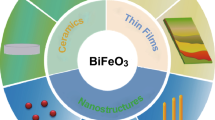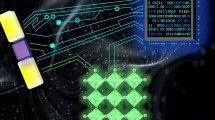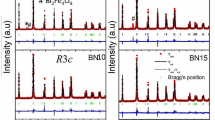Abstract
Inorganic relaxor ferroelectric solid solution single crystals are spurring new generations of high performance electromechanical devices, including transducers, sensors, and actuators, due to their ultrahigh electric field induced strain, large piezoelectric constant, high electromechanical coupling factor and low dielectric loss. However, relaxor ferroelectric single crystals found in organic-inorganic hybrid perovskites are very limited, but achieving these superior properties in them will be of great significance in the design of modern functional materials. Fortunately, here the first two-dimensional (2D) organic-inorganic hybrid relaxor ferroelectric single crystal, [Br(CH2)3NH3]2PbBr4 (BPA2-PbBr4, BPA = 3-bromopropylamine), achieves some of superior properties. Interestingly, BPA2-PbBr4 reveals a successive relaxor ferroelectric-ferroelectric-paraelectric phase transitions accompanying by a large degree of relaxation ΔTrelax = 61 K and ultralow energy loss (tanδ<0.001). Meanwhile, it exhibits a superior second harmonic generation (SHG) effect with maximum value accounts for 95% of the standard KDP due to great deformation of structure (3.2302×10−4). In addition, temperature dependent luminescence spectra (80–415 K) exhibit fluorescence and phosphorescence overlapping emission originated from inorganic and organic components with the nanosecond-scale short lifetime and the millisecond-scale long lifetime, respectively, and the color of the emitted light is continuously adjustable, which is the first to achieve luminescence and relaxor ferroelectricity compatibility.

Similar content being viewed by others
References
Chu B, Zhou X, Ren K, Neese B, Lin M, Wang Q, Bauer F, Zhang QM. Science, 2006, 313: 334–336
Larcher D, Tarascon JM. Nat Chem, 2015, 7: 19–29
Ji C, Sun Z, Zeb A, Liu S, Zhang J, Hong M, Luo J. J Phys Chem Lett, 2017, 8: 2012–2018
Kutnjak Z, Petzelt J, Blinc R. Nature, 2006, 441: 956–959
Zhang QM, Bharti V, Zhao X. Science, 1998, 280: 2101–2104
Pan H, Lan S, Xu S, Zhang Q, Yao H, Liu Y, Meng F, Guo EJ, Gu L, Yi D, Renshaw Wang X, Huang H, MacManus-Driscoll JL, Chen LQ, Jin KJ, Nan CW, Lin YH. Science, 2021, 374: 100–104
Burns G, Dacol FH. Phys Rev B, 1983, 28: 2527–2530
Liu Y, Zhang B, Xu W, Haibibu A, Han Z, Lu W, Bernholc J, Wang Q. Nat Mater, 2020, 19: 1169–1174
Sun E, Cao W. Prog Mater Sci, 2014, 65: 124–210
Park SE, Shrout TR. J Appl Phys, 1997, 82: 1804–1811
Lee SG, Monteiro RG, Feigelson RS, Lee HS, Lee M, Park SE. Appl Phys Lett, 1999, 74: 1030–1032
Yamashita Y, Harada K, Saitoh S. Ferroelectrics, 1998, 219: 29–36
Polman A, Atwater HA. Nat Mater, 2012, 11: 174–177
Li L, Shang X, Wang S, Dong N, Ji C, Chen X, Zhao S, Wang J, Sun Z, Hong M, Luo J. J Am Chem Soc, 2018, 140: 6806–6809
You YM, Liao WQ, Zhao D, Ye HY, Zhang Y, Zhou Q, Niu X, Wang J, Li PF, Fu DW, Wang Z, Gao S, Yang K, Liu JM, Li J, Yan Y, Xiong RG. Science, 2017, 357: 306–309
Hua XN, Liao WQ, Tang YY, Li PF, Shi PP, Zhao D, Xiong RG. J Am Chem Soc, 2018, 140: 12296–12302
Liu HY, Zhang HY, Chen XG, Xiong RG. J Am Chem Soc, 2020, 142: 15205–15218
Guo H, Liu P, Zheng S, Zeng S, Liu N, Hong S. Curr Appl Phys, 2016, 16: 1603–1606
Shi C, Ma JJ, Jiang JY, Hua MM, Xu Q, Yu H, Zhang Y, Ye HY. J Am Chem Soc, 2020, jacs.0c00480
Wei WJ, Jiang XX, Dong LY, Liu WW, Han XB, Qin Y, Li K, Li W, Lin ZS, Bu XH, Lu PX. J Am Chem Soc, 2019, 141: 9134–9139
Even J, Pedesseau L, Katan C. ChemPhysChem, 2014, 15: 3733–3741
Tan C, Cao X, Wu XJ, He Q, Yang J, Zhang X, Chen J, Zhao W, Han S, Nam GH, Sindoro M, Zhang H. Chem Rev, 2017, 117: 6225–6331
Jemli K, Audebert P, Galmiche L, Trippé-Allard G, Garrot D, Lauret JS, Deleporte E. ACS Appl Mater Interfaces, 2015, 7: 21763–21769
Li C, Li LS, Wei WJ, Tan YH. Inorg Chem, 2019, 58: 9733–9737
Gao HQ, Wei WJ, Tan YH, Tang YZ. Chem Mater, 2020, 32: 6886–6891
Du K, Tu Q, Zhang X, Han Q, Liu J, Zauscher S, Mitzi DB. Inorg Chem, 2017, 56: 9291–9302
Alonso JA, Martínez-Lope MJ, Casais MT, Fernández-Díaz MT. Inorg Chem, 2000, 39: 917–923
Ji C, Wang S, Li L, Sun Z, Hong M, Luo J. Adv Funct Mater, 2018, 29: 1805038
Wang S, Yao Y, Kong J, Zhao S, Sun Z, Wu Z, Li L, Luo J. Chem Commun, 2018, 54: 4053–4056
Ji C, Dey D, Peng Y, Liu X, Li L, Luo J. Angew Chem, 2020, 132: 19095–19099
Aizu K. J Phys Soc Jpn, 1969, 27: 387–396
Zhang W, Xiong RG. Chem Rev, 2012, 112: 1163–1195
Shi PP, Tang YY, Li PF, Liao WQ, Wang ZX, Ye Q, Xiong RG. Chem Soc Rev, 2016, 45: 3811–3827
Ye HY, Liao WQ, Hu CL, Zhang Y, You YM, Mao JG, Li PF, Xiong RG. Adv Mater, 2016, 28: 2579–2586
Viehland D, Jang SJ, Cross LE, Wuttig M. J Appl Phys, 1990, 68: 2916–2921
Bing YH, Bokov AA, Ye ZG. Curr Appl Phys, 2011, 11: S14–S21
Randall CA, Fan Z, Reaney I, Chen L, Trolier-McKinstry S. J Am Ceram Soc, 2021, 104: 3775–3810
Tauc J. Mater Res Bull, 1970, 5: 721–729
Dohner ER, Hoke ET, Karunadasa HI. J Am Chem Soc, 2014, 136: 1718–1721
Dohner ER, Jaffe A, Bradshaw LR, Karunadasa HI. J Am Chem Soc, 2014, 136: 13154–13157
Yu J, Kong J, Hao W, Guo X, He H, Leow WR, Liu Z, Cai P, Qian G, Li S, Chen X, Chen X. Adv Mater, 2018, 1806385
Hao X, Zhai J, Kong LB, Xu Z. Prog Mater Sci, 2014, 63: 1–57
Acknowledgements
This work was supported by the National Natural Science Foundation of China (22001102, 21788102), the Jiangxi Provincial Natural Science Foundation (20202BAB213002), the Education Department of Jiangxi Province (GJJ190474), the Fundamental Research Funds for the Central Universities (JXUST, 205200100116) and the Program for Excellent Young Talents (JXUST, JXUSTQJYX2020018).
Author information
Authors and Affiliations
Corresponding authors
Ethics declarations
Conflict of interest The authors declare no conflict of interest.
Additional information
Supporting information The supporting information is available online at https://chem.scichina.com and https://link.springer.com/journal/11426. The supporting materials are published as submitted, without typesetting or editing. The responsibility for scientific accuracy and content remains entirely with the authors.
Supplementary Information
Rights and permissions
About this article
Cite this article
Wei, W., Gao, H., Fang, M. et al. The first 2D organic-inorganic hybrid relaxor-ferroelectric single crystal. Sci. China Chem. 66, 466–474 (2023). https://doi.org/10.1007/s11426-022-1446-3
Received:
Accepted:
Published:
Issue Date:
DOI: https://doi.org/10.1007/s11426-022-1446-3




